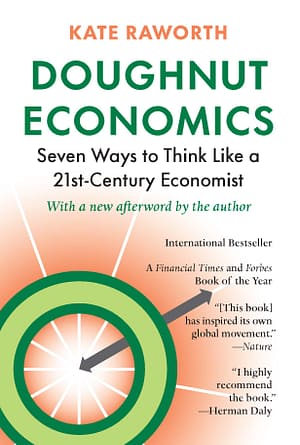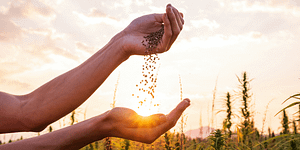The Twenty-First-Century Economist: Seven Ways to Think Like One

We’ve come a long way since the days of horse-drawn buggies and telegrams: We can send messages to someone across the globe in seconds, travel overseas takes hours not days, and yet, when it comes to how we think about the economy, we’re centuries behind the times. Renegade economist, Kate Raworth, proposes an entirely new approach to economic systems thinking designed to help us develop new standards for economic success.
The following excerpt is from Doughnut Economics by Kate Raworth. It has been adapted for the web.
Seven Ways to Think Like a Twenty-First-Century Economist
Whether you consider yourself an economic veteran or novice, now is the time to uncover the economic graffiti that lingers in all of our minds and, if you don’t like what you find, scrub it out; or, better still, paint it over with new images that far better serve our needs and times. The rest of this book proposes seven ways to think like a twenty-first-century economist, revealing for each of those seven ways the spurious image that has occupied our minds, how it came to be so powerful and the damaging influence it has had. But the time for mere critique is past, which is why the focus here is on creating new images that capture the essential principles to guide us now. The diagrams in this book aim to summarise that leap from old to new economic thinking. Taken together, they set out—quite literally—a new big picture for the twenty-first-century economist. So here is a whirlwind tour of the ideas and images at the heart of Doughnut Economics.
First, change the goal.
For over 70 years, economics has been fixated on GDP, or national output, as its primary measure of progress. That fixation has been used to justify extreme inequalities of income and wealth coupled with unprecedented destruction of the living world. For the twenty-first century, a far bigger goal is needed: meeting the human rights of every person within the means of our life-giving planet. And that goal is encapsulated in the concept of the Doughnut. The challenge now is to create economies—local to global—that help to bring all of humanity into the Doughnut’s safe and just space. Instead of pursuing ever-increasing GDP, it is time to discover how to thrive in balance.
Second, see the big picture.
Mainstream economics depicts the whole economy with just one, extremely limited image, the Circular Flow diagram. Its limitations have, furthermore, been used to reinforce a neoliberal narrative about the efficiency of the market, the incompetence of the state, the domesticity of the household and the tragedy of the commons. It is time to draw the economy anew, embedding it within society and within nature, and powered by the sun. This new depiction invites new narratives—about the power of the market, the partnership of the state, the core role of the household and the creativity of the commons.
Third, nurture human nature.
At the heart of twentieth-century economics stands the portrait of rational economic man: he has told us that we are self-interested, isolated, calculating, fixed in taste and dominant over nature—and his portrait has shaped who we have become. But human nature is far richer than this, as early sketches of our new self-portrait reveal: we are social, interdependent, approximating, fluid in values and dependent upon the living world. What’s more, it is indeed possible to nurture human nature in ways that give us a far greater chance of getting into the Doughnut’s safe and just space.
Fourth, get savvy with systems.
The iconic criss-cross of the market’s supply and demand curves is the first diagram that every economics student encounters, but it is rooted in misplaced nineteenth-century metaphors of mechanical equilibrium. A far smarter starting point for understanding the economy’s dynamism is systems thinking, summed up by a simple pair of feedback loops. Putting such dynamics at the heart of economics opens up many new insights, from the boom and bust of financial markets to the self-reinforcing nature of economic inequality and the tipping points of climate change. It’s time to stop searching for the economy’s elusive control levers and start stewarding it as an ever-evolving complex system.
Fifth, design to distribute.
In the twentieth century, one simple curve—the Kuznets Curve—whispered a powerful message on inequality: it has to get worse before it can get better, and growth will (eventually) even it up. But inequality, it turns out, is not an economic necessity: it is a design failure. Twenty-first-century economists will recognise that there are many ways to design economies to be far more distributive of the value that they generate—an idea best represented as a network of flows. It means going beyond redistributing income to exploring ways of redistributing wealth, particularly the wealth that lies in controlling land, enterprise, technology, knowledge and the power to create money.
Sixth, create to regenerate.
Economic theory has long portrayed a ‘clean’ environment as a luxury good, affordable only for the well-off. This view was reinforced by the Environmental Kuznets Curve, which once again whispered that pollution has to get worse before it can get better and growth will (eventually) clean it up. But there is no such law: ecological degradation is simply the result of degenerative industrial design. This century needs economic thinking that unleashes regenerative design in order to create a circular—not linear—economy and to restore humans as full participants in Earth’s cyclical processes of life.
Seventh, be agnostic about growth.
One diagram in economic theory is so dangerous that it is never actually drawn: the long-term path of GDP growth. Mainstream economics views endless economic growth as a must, but nothing in nature grows forever, and the attempt to buck that trend is raising tough questions in high-income but low-growth countries. It may not be hard to give up having GDP growth as an economic goal, but it is going to be far harder to overcome our addiction to it. Today we have economies that need to grow, whether or not they make us thrive; what we need are economies that make us thrive, whether or not they grow. That radical flip in perspective invites us to become agnostic about growth and to explore how economies that are currently financially, politically and socially addicted to growth could learn to live with or without it.
These seven ways of thinking like a twenty-first-century economist don’t lay out specific policy prescriptions or institutional fixes. They promise no immediate answers for what to do next, and they are not the whole answer. But I am convinced that they are fundamental to the radically different way of thinking about economics that this century demands. Their principles and patterns will equip new economic thinkers—and the inner economist in us all—to start creating an economy that enables everyone in the house to prosper. Given the speed, scale and uncertainty of change that we face in coming years, it would be foolhardy to attempt to prescribe now all the policies and institutions that will be fit for the future: the coming generation of thinkers and doers will be far better placed to experiment and discover what works as the context continually changes. What we can do now—and must do well—is bring together the best of the emerging ideas, and so create a new economic mindset that is never set but always evolving.
The task for economic thinkers in the decades ahead will be to bring these seven ways of thinking together in practice and to add to them many more. We have barely set out on this adventure in rethinking economics. Join the crew.
Recent Articles
Using herbal medicine to heal the body is an ancient practice. It has since become a worldwide industry. Today, modern-day doctor’s visits and industrial medicine have displaced common knowledge of herbal medicine. Some still remember the ancient practice. In her book Following the Herbal Harvest, Ann Armbrecht interviews one such person, Phyllis Light, a fourth-generation…
Read MoreAddressing the pressing issues affecting everyday Americans is essential—and one of our nation’s most profound challenges is the devastating impact of mass layoffs. Layoffs upend people’s lives, cause enormous stress, and lead to debilitating personal debt. The societal harm caused by mass layoffs has been known for decades. Yet, we do little to stop them.…
Read MoreIn a personal investigation into ethical and traceable leather, fashion designer Alice Robinson begins a ground-breaking journey into the origin story of leather and its connection to food and farming. Keep reading to learn more about her process of cutting & shaping leather to create handbags, shoes, clothing, and more! The following is an excerpt from…
Read MoreWe’ve all heard of the phrases “time flies” and “time heals all wounds,” but what really is time, and how does it impact our lives? The concept of time may be even more powerful than we think, especially when it comes to the money we save and spend. The following is an excerpt from The…
Read MoreVandana Shiva has been described in many ways: the “Gandhi of Grain,” “a rock star” in the battle against GMOs, and “the most powerful voice” for people of the developing world. For over four decades she been at the forefront of seed saving, seed sovereignty, and connecting the dots between the destruction of nature, the polarization…
Read More









